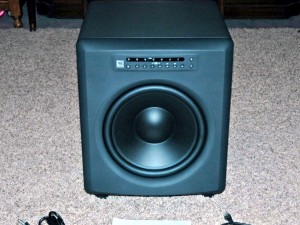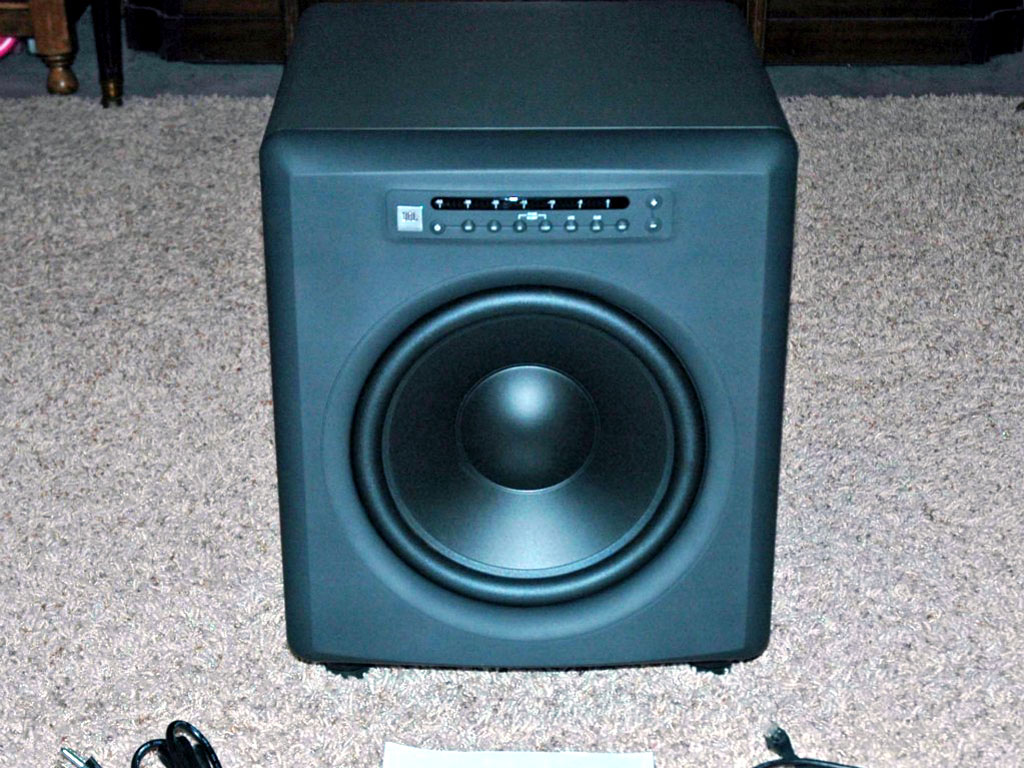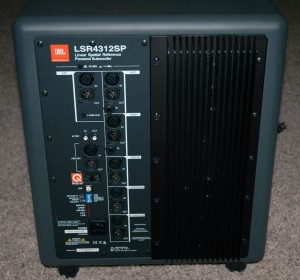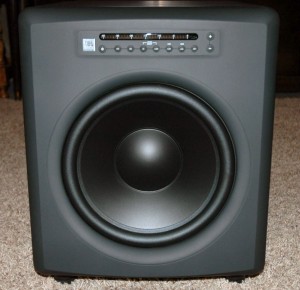The LSR 4300 series of monitors from JBL — including the 4326 and 4328 with 6- and 8-inch woofers, respectively — have been widely praised for their sound quality and modernistic networking features. They first gained my attention in 2006, when I test-drove a 4328 pair (sans sub) and found the monitors quite pleasing in both timbre and construction. I thought the RMC (Room Mode Correction, JBL’s system of reducing low-frequency room resonances) was interesting, but ultimately useless to me as I had a 15-inch powered sub from another manufacturer that could not be controlled by the software. Philosophically and practically, I insisted on full-range monitoring, so I knew that I had to wait until JBL had an LSR sub that could truly complete the system. This brings us to today.
JBL LSR4312SP review
Features
The LSR 4312SP is the logical extension of the previous LSR models in every way. Matching in material and design, this selfpowered, 450-watt RMS, forward-firing, bottom-ported subwoofer (12-inch woofer, selfshielded, neodymium motor structure, response -6 dB at 27 Hz, -10 dB at 24 Hz, 116 dB continuous SPL) incorporates into Harman’s HiQnet protocol, allowing adjustment of the sub’s volume, bass management and RMC selection from either your computer or the supplied remote control. All of these controls are also found on the front panel of the 4312, which is simplistically attractive with its grill-free design and “soft touch” rubberpaint surface. The 4312 measures 19.75 inches high x 16 inches wide x 19.5 inches deep, and has an MSRP of $1,139.
The rear panel is where the 4312’s many I/O’s are contained, including six analog inputs (L, C, R, LS, RS, and LFE) on XLRs (and their accompanying XLR pass-thru outputs), twochannel AES/EBU I/O, and, finally, S/PDIF in and out. There are two balanced quarter-inch inputs on the Left and Right inputs only, as well as a -10 dB gain selector at the LFE input. Additionally, there are two HiQnet connections (using RJ45 connectors), a series of six dipswitches (for switching polarity and settings for digital inputs), an IEC power connector, and five LEDs indicating input selection.
For further detail on the construction, design, and theory behind the LSR monitors, please see Russ Long’s excellent and thorough review for PAR. With such an understanding of the LSR system and the RMC calibration, I was set to disassemble my current 2.1 system, a pair of Event 20/20 nearfields and accompanying 20/20/15, 15-inch, 250-watt RMS woofer. This system was comparable to the JBLs in many ways — internal biamplification, similar amounts of RMS power to the drivers, same driver sizes (except for the larger sub) and even tweeter construction (1-inch soft-dome silk) which had been a primary factor in selecting the 20/20s (a nonfatiguing top end is quite important to me).
JBL LSR4312SP In Use
Upon first powering up, the LSR4328s indicated that RMC calibration had not yet been performed, but I proceeded to do some listening anyway. Without the 4312 sub, the 4328s were full and admirable in their bass, but not fully extended in their response. Selecting Bass Management on my remote control engaged the sub, kicking in more of that below-60 Hz information I’m so finicky about; it completed the sonic picture for me. Engineers with smaller control rooms than my 17 x 25-foot space may find the 4312 sub unnecessary, especially if they are not frequently working on music with ample low-frequency information. This review is not aimed however at such applications, but indeed maximization of the control room experience, as close to a flat 20 Hz to 20 kHz as I can get.
From the manufacturer:
“Although the LSR4328P and LSR4326P are flat to 50Hz and 55Hz, respectively, we recommend a subwoofer for any size room. Smaller rooms that do not have real bass traps may be more susceptible to LF problems. In addition to extending LF response below 30Hz, crossing over LF to the sub allows flexibility and optimum placement of the LF in the room, improving LF performance in a small room. The LSR4312SP RMC system overcomes associated boom typical in small rooms.”
That being said, the LSR system sounded well powered and loud enough for “rock band” monitoring, amply deep and full, but it still created that bottom end inconsistency I’m so unfortunately used to (two notes in the scale seemed disproportionably loud and two spots close to the mix position had quite untrustworthy bass response). At this point, I’ll confess to needing more/better bass trapping in my control room (and I’ll be getting some more soon), but the question is can the 4300s with RMC be an improvement for now?
I set up the supplied condenser mic with its head right smack in the mix position, connected it to the front left speaker (which supplied 15v phantom power) and started the RMC calibration. A series of blips and sweeps sounded at various levels and within 15 seconds RMC was done. Playback confirmed that something had been changed, as the bottom end was absent of those humps, less cloudy, a little tighter … not as bassy overall, but clearly a more even and trustworthy bottom end. The RMC works through the attenuation of 73 low-end frequencies (at 1/24 octave centers), with Q values from 1 (1.4 octaves) to 16 (1/11th of an octave), a maximum attenuation of -12 dB and the RMC overrides the rearpanel polarity dipswitch setting (when deemed necessary). I rapidly switched back and forth from non-RMC to RMC with my remote control while identifying the trouble frequencies that were notched out.
The LSR Control Software was a little confusing at first, but proved to be a valuable part of the LSR system. After connecting the left front speaker to my Mac Pro with a standard USB cable (provided), the LSR Control software allows the muting or soloing of any individual speaker, as well as other system controls. Most importantly to me, it allows you to see what changes the RMC made to your system. My curiosity was piqued, as I’m sure many of yours would be too, and here’s the numbers I found for my system:
Frequency, Q, & Gain
Left: 121; 5.01; -4.5 dB
Right: 140; 2.31; -5.5 dB
Sub: 59; 4.40; -3.5 dB
From the manufacturer:
“The correction at the left frequency listed above looks like the system compensated for proximity to a wall, or work surface — a ‘boundary condition.’”
Notice the additional gain reduction at a higher frequency in the right channel; this is to be expected as I have a large equipment rack on the right side of the mix position, which is creating a standing wave at 140 Hz as bass gathers around it. With my 4312 sub crossed over at 80 Hz (the most naturalsounding setting to me), one should note that I had frequency buildup both above and below my crossover point, requiring both the mains and the sub to be adjusted. Keep in mind that if one is using bass management, as I am, that it must be selected prior to the RMC calibration for accurate results.
There’s more to audio life than bottom end, and I must say the LSR4300 system took some getting used to at first. Even though the important midrange was quite flat, the overall sound was slightly forward, almost aggressive. The highs were crisp and uncluttered, but more piercing and revealing than I was used to. I had a number of critical projects coming up that would surely test these monitors translatability, the sub’s accuracy and my flexibility.
First up, were mixes of a five-song EP of dynamic indie rock. Although the band had a straightforward drum/bass/two-guitar attack, I was concerned with my ability to get melodic bass lines consistently audible without excessive flab and getting their dynamic female lead vocal to sit in the mix — always dominant, but seriously challenged by loud guitars. Here, 4328s and their 4312 sub simply blew me away. I got more translatability and “predictableness” than I ever got with my old system. Snare sat exactly where I knew it would (for once), guitars were perfectly even “L to R” in their almost hard-panned glory and vocals fit right into that narrow little niche I was aiming for. My “kick drum: bass guitar” balance ratio was nice and even, but overall bass levels were a touch inconsistent from mix to mix, although much better than normal for me.
Next up was mixing a full length of neometal, which incorporates enough double kicks and jagged-edge bass guitar to require a super-accurate bottom-end balance. I was concerned with keeping kick drum tight, yet large and getting bass guitar audible, despite layers of Mesa Boogie-powered guitar crunch. Again, the LSR system really impressed me. Bass guitar was not ever a problem, staying audible in the mixes without muddiness, a testament to the truthful low-mid response of the 4328s. Kicks sat right where I hoped they would without any frequency response humps like I’m often used to getting. Still, the overall bass content of my mixes was a little less than consistent, so I tried EQing the system a bit.
Using the Control Software (although I could have used the remote) I fiddled with the low and high shelving EQ, experimenting with different corner frequencies and value. Only two dB of boost or cut is offered, but a slight bottom boost and top cut got me where things sounded a little more pleasant to my ear … just in time, as I had to master a compilation CD for the local entertainment weekly. Here, the 4328s and the 4312 sub really rose to the occasion, allowing me to hear detail and imbalance in the mixes that I quickly corrected. The music wildly veered from country, to rap, from indie to pop, but “the moving bullseye” of consistent bass was easy to hit. On a 12-song CD, I only retouched the EQ (after some real-world testing in my car, computer, headphones, etc.) on two songs — way better than my typical results. I found my QC procedures to be much more “double-checking” than revealing.
JBL was kind enough to provide a second 4312 subwoofer for this review, and the performance was predictably positive. With such a 2.2 system, bass management must be selected to engage the subs, but their information is not summed, the bottom stays in true stereo, like the top end. The second subwoofer allowed the system to have more headroom and achieve higher bass output levels, but performance was not improved much at lower monitoring levels. The use of a second sub would be highly recommended for audio post applications, especially if there were a true LFE output.
Be forewarned: with a second sub and RMC, one can spend a lot of time experimenting with placement and analyzing the results the myriad of combinations can be both useful and overwhelming.
Summary
Now that I’ve tasted the sweet fruit of total monitoring system control, I’m never going back. I have always found it hard to get levels exactly matched from left to right speaker and even harder to calibrate my sub properly (what with subjective crossover frequency, level, placement and polarity adjustments). The ease of the RMC setup and the consistency of the results has been an eyeopener for me. A perfectly tuned system, with speaker muting, dimming and soloing, remote control and bass management gives you very significant tools that will help you work better and faster.
Those of you with 4326s or 4328s should seriously consider adding the 4312 sub and completing the system. Then, for those of you who are considering affordable, widely available professional bass trapping products for your room, rest assured that the final hurdle, more accurate monitoring, is now clearable thanks to a system anchored by a LSR4312SP.
Review setup
Soundcraft Ghost mixing console, Digital Performer 5.12 workstation, Mac Pro computer, Lucid Gen X 6-96 wordclock
Fast Facts
Applications
Studio, project studio, audio post, and broadcast recording and mixing environments
Key Features
I/O includes six analog inputs (L, C, R, LS, RS and LFE) on XLRs (and their accompanying XLR pass-thru outputs), AES/EBU I/O, S/PDIF I/O, two quarter-inch inputs (L/R only); – 10 dB gain selector at LFE in; two HiQnet connections with RJ45 connectors; six dipswitches (for switching polarity and crossover point), an IEC power connector, and five LEDs indicating input selection; measures 19.75 inches high x 16 inches wide x 19.5 inches deep
Price
$1,139 list
Contact
JBL Professional | 818-894-8850 | www.jblpro.com/LSR
Product points
Plus
- Deep, full, extended bass with adequate amplifier headroom
- Definite improvements in mix consistency and bass definition
- Remote control and LSR software are extremely helpful
Minus
- Driver is exposed and could be damaged easily
Score
Accurate monitoring in acoustically challenging environments is a hurdle now clearable thanks to a system anchored by a LSR4312SP.
by Rob Tavaglione


